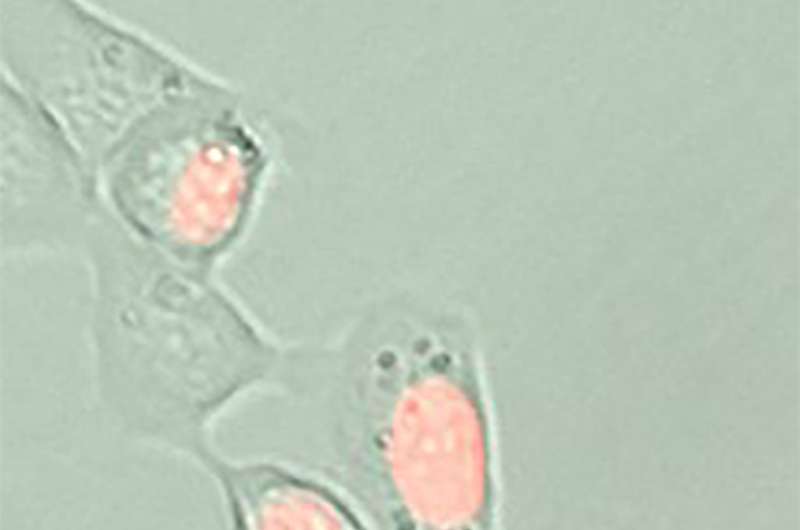How "sleeper cells" in cancerous tumours can be destroyed

In many metastasised types of cancer, disseminated tumours grow back despite successful chemotherapy. As a research team under the direction of the University of Bern, Switzerland, has now discovered, this is because of isolated cancer cells that survive the chemotherapy due to a phase of dormancy. If these "sleeper cells" possess specific defects, however, they can be destroyed. This could increase the efficacy of chemotherapy for certain patients.
Many people have experienced this among their family, friends or acquaintances: at first, the chemotherapy is extremely effective in cancer patients, although the tumour has metastasised, i.e. it has settled in remote tissue. In some cases the cancer even seems to have been eradicated. But then comes the disillusioning news: a few cancer cells have survived and are multiplying again. Sometimes they respond to renewed treatment, but then develop a resistance against all methods of therapy.
"We are interested in the question of how individual cells can survive the therapy," says Sven Rottenberg of the Vetsuisse Faculty of the University of Bern. An international research team under his direction has now identified so-called sleeper cells that escape treatment. Because chemotherapies are especially aimed at active, dividing tumour cells, some of these sleeper cells can survive by means of a short pause in their growth. After the therapy has ended, they then start to multiply again. If, however, these sleeper cells have a specific mutation that prevents them from repairing damage to their own DNA, they can be destroyed in a targeted way using anti-cancer drugs. The study has now been published in the journal Clinical Cancer Research.
Possible alternatives to immunotherapy
If tumours grow back again after a treatment, they sometimes react to the same chemotherapy again. In that case, they have not acquired so-called "secondary resistance", because then they would simply continue to grow in the event of repeated therapy. "We refer to the few remaining tumour cells, which survive chemotherapy, as so-called 'drug-tolerant cells'," says Rottenberg. How can one destroy these remaining cells? "For certain types of cancer, such as leukaemia and melanoma, enormous progress has already been made in the field of immunotherapy. This is characterised by the targeted strengthening of the body's own immune cells, unlike in chemotherapy, in which the aim is direct destruction of the cancer cells. With this strengthening of the immune system, directed against the cancer cells, the drug-tolerant cells can also be eliminated in some patients." According to Rottenberg, this new immunotherapy has been only modestly successful when used on other frequent tumours such as breast cancer– also, it results in side-effects and enormous costs.
Now, the researchers have discovered an alternative in a mouse model: in the case of breast tumours with a specific defect in DNA repair, the animals can be cured using already established, cheap chemotherapy drugs, if enough DNA damage can be inflicted on the resting tumour cells. Rottenberg hopes that in the future, based on these findings, the treatment of breast, ovarian and prostate cancer can be improved.
Defect in DNA repair as cancer cells' Achilles heel
The background to this is the progress achieved in the field of personalised medicine. Types of cancer are no longer divided up and treated according to the origin of the tissue; instead, targeted analyses (such as the sequencing of genes or examination for the presence of certain proteins) are carried out to detect individual mutations that can be exploited in the therapy. Defects in DNA repair are one example. They occur due to a malfunction of proteins that repair DNA damage in normal body cells. If these proteins are inactive – which is the case in many patients with breast, ovarian or prostate cancer – the result is a flawed repair. This can be exploited in the therapy, as Rottenberg explains: "DNA-repair-defective sleeper cells respond to particular substances that damage DNA." These substances affect healthy cells as well as the cancer. Unlike normal cells, however, the tumour cells are considerably more sensitive, because they cannot repair damage well. In the animal model, so-called DNA crosslinkers have shown to be very efficient at this. These have already been on the market for a long time, but have not previously been used for types of cancer with such defects.
Like most anti-cancer drugs, these substances also have strong side-effects such as bone-marrow damage. With certain patients, however, these side-effects could be balanced out with stem-cell transplants, as in leukaemia treatments. "Initial clinical tests in the Netherlands have shown that some breast cancer patients with metastasised breast cancer were actually cured by such intensified chemotherapy," says Rottenberg.
More information: Marina Pajic et al. Selected Alkylating Agents Can Overcome Drug Tolerance of G 0 -like Tumor Cells and Eradicate BRCA1-Deficient Mammary Tumors in Mice, Clinical Cancer Research (2017). DOI: 10.1158/1078-0432.CCR-17-1279















